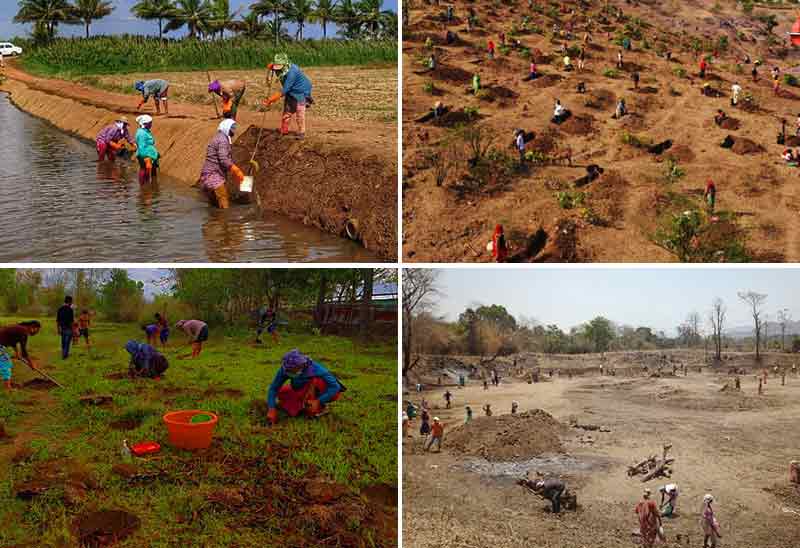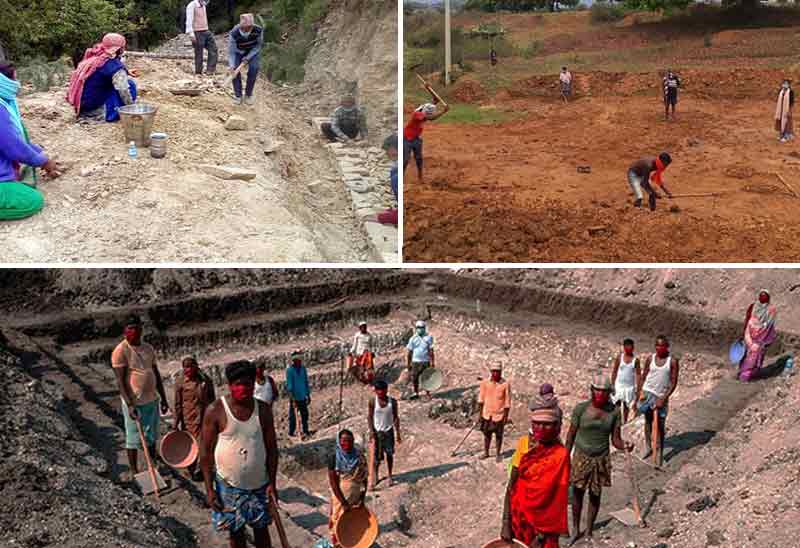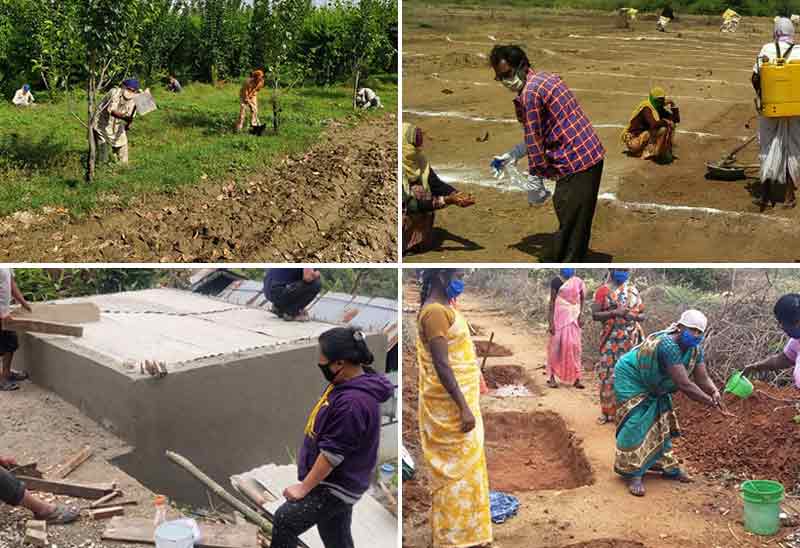- India
- Feb 01
Work demand in MGNREGS back to pre-pandemic level
The work demand under the Mahatma Gandhi National Rural Employment Guarantee Scheme (MGNREGS) hovered around the pre-pandemic level between July to November 2022, the Economic Survey 2022-23 said.
Key points mentioned in Economic Survey:
• In FY23, as on January 24, 2023, as many as 6.49 crore households demanded employment under MGNREGS, and 6.48 crore households were offered employment out of which 5.7 crore availed employment.
• The number of persons demanding work under MGNREGS was seen to be trending around pre-pandemic levels from July to November 2022. This could be attributed to the normalisation of the rural economy due to strong agricultural growth and a swift recovery from COVID induced slowdown, culminating in better employment opportunities.
• The number of works done under MGNREGS has steadily increased over the years, with 85 lakh completed works in financial year 2021-22 and 70.6 lakh completed works in the current financial year by January.
• The share of works done on individual’s land has increased from 16 per cent of the total completed works in 2015-16, to 73 per cent in 2022-23.
• These works include creating household assets such as animal sheds, farm ponds, dug wells, horticulture plantations, vermicomposting pits etc., in which the beneficiary gets both labour and material costs as per standard rates.
• Empirically, within a short span of 2-3 years, these assets have been observed to have a significant positive impact on agricultural productivity, production-related expenditure, and income per household, along with a negative association with migration and fall in indebtedness, especially from non-institutional sources.
• This has long-term implications for aiding income diversification and infusing resilience into rural livelihoods.
What is MGNREGS?
• Mahatma Gandhi National Rural Employment Guarantee Scheme (MGNREGS) is a demand driven wage employment programme, which provides for livelihood security by providing at least one hundred days of guaranteed wage employment in every financial year to every rural household whose adult members volunteer to do unskilled manual work.
• In case employment is not provided within 15 days from the date of registration of the demand for work or the date from which work has been demanded in case of advance applications, whichever is later, the worker is entitled to a daily unemployment allowance.
• MGNREGS aims to strengthen the livelihood resource base of the rural households while creating productive assets.
• The Parliament passed the Mahatma Gandhi National Rural Employment Guarantee Act (MGNREGA) in August 2005. It came into force on February 2, 2006.
• MGNREGS was initially implemented in 200 districts and extended subsequently to other districts. At present, it covers over 700 districts.
• Wage rates for workers under the MGNREGA are notified and revised annually. MGNREGA wages are paid based on measurement of work done. Every state has its defined Schedule of Rates on the basis of which the work output is defined and used to calculate the wages for MGNREGA beneficiaries. The actual wage payable is calculated based on the output of the worker.
Goals of the scheme:
i) Social protection for the most vulnerable people living in rural India by guaranteeing wage employment opportunities.
ii) Enhance livelihood security of the rural poor through generation of wage employment opportunities in works leading to creation of durable assets.
iii) Rejuvenate natural resource base of rural areas.
iv) Create a durable and productive rural asset base.
v) Empowerment of the socially disadvantaged, especially, women, Scheduled Castes (SCs) and Scheduled Tribes (STs), through the processes of a rights-based legislation.
vi) Strengthen decentralised, participatory planning through convergence of various anti-poverty and livelihoods initiatives.
vii) Deepen democracy at the grassroots by strengthening Panchayati Raj Institutions.
Achievements under MGNREGS
i) Geo-tagging of the assets: Geo MGNREGA Phase-I was rolled out on September 1, 2016 for geotagging of all completed works which started before November 1, 2017, under the scheme. Geo MGNREGA Phase-II was rolled out on November 1, 2017 and under this phase, the geo-tagging of assets is carried out in three stages — before initiation of work, during the work, and after completion of work. More than 5.2 crore assets have been geo-tagged (as on January 6, 2023) and made available in the public domain.
ii) Mandatory expenditure on agriculture and allied activities: As per the provision of the Act, the District Programme Coordinator is required to ensure that at least 60 per cent of the works to be taken up in a district in terms of cost shall be for the creation of productive assets directly linked to agriculture and allied activities through development of land, water, and trees. The expenditure on agriculture and allied activities is 68.5 per cent in FY23 (as on January 6, 2023).
iii) e-Payments: e-payments are done under MGNREGA using National Electronic Fund Management System (Ne-FMS)/ Electronic Fund Management System (e-FMS) for the payment of wages of workers directly to their bank/post office accounts. So far, total expenditure through NeFMS/e-FMS is 99.7 per cent.
iv) Direct Benefit Transfer: Under the scheme, 99 per cent of wage seekers are receiving their wages directly into their bank accounts. It is a big step towards transparency.
v) Aadhaar-based payment: 14 crore Aadhaar cards have been seeded in Management Information System (MIS) which is 92 per cent of total active workers (15.3 crore). A total of 7.9 crore workers have been linked to the Aadhaar Based Payment System.
vi) Cluster Facilitation Project (CFP): The Cluster Facilitation Project (CFP) has been rolled out in 300 blocks of the country, from April 1, 2020. It aims to ensure effective implementation of MGNREGA for accelerated development in 250 blocks of 117 aspirational districts and 50 blocks of other backward regions through better planning, monitoring and coordination by providing thematic experts in various domains at national, state, district and block level. CFP is operational in 29 states/UTs.
Some of the good governance initiatives under the scheme are:
a) The Job Cards (JC) need to be verified and updated from time to time to weed out the bogus JCs, duplicates, and for reasons like migration and death. The states/ UTs have taken up this exercise to verify/ update the JCs.
b) The number of registers (average 22 registers in a Gram Panchayat) being maintained at every Gram Panchayat has been brought down to seven registers.
c) Cases of violation of guidelines and schedules are being followed up regularly. The Interstate Standard Operating Procedures (SoP) for visits were developed to improve the quality of the social audit process for all the states/UTs. This SoP will ensure all the Social Audit compliance as per Audit Standard Rule, 2011 which includes the establishment of an independent social audit unit, independent social audit director, and complete human resources to be trained as Village Resource Persons (VRPs), timely calendar upload on Management Information System (MIS), timely conduct of the regular audit and uploading the issues on MIS within the stipulated timeline.
d) MGNREGA workers are being trained under recent initiatives like Barefoot Technicians (BFT) to move them up the skilling ladder. So far, 8,394 BFTs have been trained in 20 states.
e) The project Unnati intends to upgrade the skill base of the MGNREGS workers, and thereby improve their livelihoods so that they can move from their current partial employment to full employment. This project was launched in the FY20 and aims to enhance the skill base of two lakh MGNREGA beneficiaries in three years — FY20, FY21 and FY22. So far, about 27,383 candidates have been trained. Unnati skilling project is meant to provide training to one adult member (of age 18-45 years) of a household who has completed 100 days of work under MGNREGA in the financial year from FY19. Full expenditures towards a stipend, against wage loss compensation, are entirely borne by the central government.
f) Around 5.5 crore households fall under the category of landless households dependent on manual casual labour for livelihood as per the Socio Economic and Caste Census (SECC) 2011. The government is making all efforts to get these households, not having JCs, to obtain employment under MGNREGA. Around 4.6 crore such households have been surveyed.
g) Area Officer Monitoring app was launched in May 2021, in a bid to facilitate the authorities to record their findings online. It will also help in recording time-stamped and geo-coordinate tagged photographs for all the schemes of the Department of Rural Development. It facilitates analysis of findings which in turn help in the implementation of the programme in a better manner.
h) National Mobile Monitoring Software (NMMS) app was launched in May 2021 which permits taking real-time attendance of workers at MGNREGA worksites along with a geo-tagged photograph. This app is a step towards bringing transparency and proper monitoring of the schemes and will help in increasing citizen oversight of the programme.
Manorama Yearbook app is now available on Google Play Store and iOS App Store




